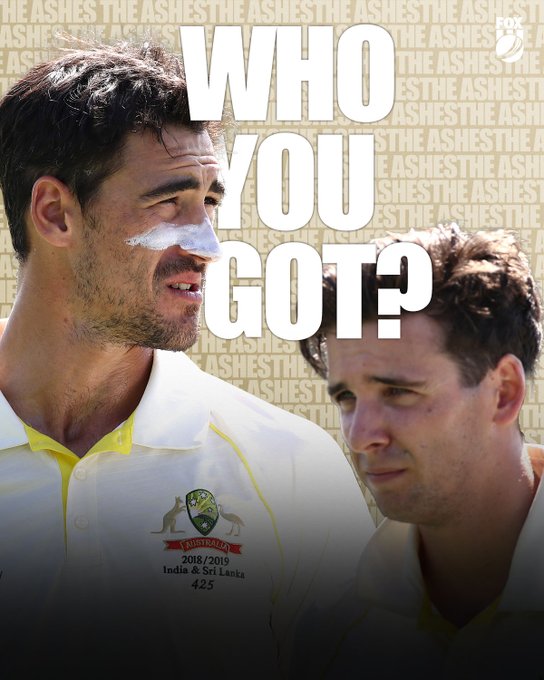
Mitchell Starc's sense of déjà vu feels different this time

Till a month ago, Mitchell Starc was in the news for all the right reasons. The left-arm pacer, who has been indispensable to Australia’s white-ball setup, was busy hustling and harrying batters with his raw pace at the T20 World Cup.
At one point, he was arguably the Aussies’ most potent bowling threat as they shifted through the gears and cast themselves as favourites for the competition. However, it all came to a grinding halt as Starc entered the knock-out stages.
In the semi-final, he was bludgeoned into submission by Fakhar Zaman. A game later, Kane Williamson tore Starc to shreds. So much so that many were left wondering what the aura and the fear factor around Starc was all about.
Australia ultimately won the T20 World Cup, meaning that the fast bowler’s performance wasn’t dissected as much. However, that display, coupled with Starc’s general ineffectiveness in Test cricket, has meant that there have been murmurs of discontent – murmurs suggesting that the left-arm seamer shouldn’t have been included in Australia’s XI for the Ashes opener at the Gabba.
Shane Warne, in particular, has been quite vocal about this particular quandary, suggesting that Jhye Richardson is a much better alternative than Starc. To an extent, the former Australian spinner’s claims aren’t baseless, considering Starc has been pretty ordinary in red-ball cricket since the start of 2020.
Mitchell Starc hasn't been at his best in Test cricket lately
In the aforementioned period, Starc has only accounted for 15 batters across 10 innings – roughly equating to 1.5 wickets per essay. He has also averaged 35.33 and has conceded runs at an economy rate of 3.17. Not only has he been unable to run through batting units, he has also conceded more runs than what would be deemed ideal.
The strike rate, though, is perhaps the biggest drawback, considering Starc prides himself on picking up a heap of wickets. His overall strike rate is a tick over 49 (49.3 to be precise). In this phase, however, it spirals up to 66.8, meaning that he has had to bowl a minimum of 11 overs before being successful.
Apart from that, Starc has also developed a tendency to lethal against the lower-order batters – something that isn’t a vice prima facie. Yet, when considering his record against top order batters - he has only dismissed openers five times since 2020 as opposed to 8 lower-order wickets (No.6, 7 and 8), it becomes a slight concern.
Moreover, Starc, who relies on swing and reverse-swing to break through, might not be accorded that luxury very much, especially in Australia. Remember, Starc has only played at home since the start of 2020. Hence, a case could be made that his stock is firmly on the wane.
However, one thing that Starc has going for him is that he knows how to silence doubters and prove them wrong, especially when that doubter is Warner. While he has previously said he doesn’t want to indulge in much of a conversation with the former leg-spinner, it certainly is something that gets him fired up.
Back in 2014, just before the 2015 ICC Cricket World Cup, Warne had labelled Starc’s body language a touch too languid or “soft”. The pacer took that on board and obliterated every opposition on his way to World Cup glory.

The major difference, though, is that Starc had the comfort of white-ball cricket to fall back on. To add further context, when a similar situation played out before the 2019 Ashes, Warne was vindicated as Starc returned with series figures of 4 wickets in 2 innings at 31.50. The fact that he only played a solitary game was indicative of how his Test career still leaves a lot to be desired.
From that perspective, it seems highly unclear how the 2021 narrative is going to pan out. Warne is right in hinting that Starc may not be Australia’s best alternative and the seamer is also right in not paying too much heed to what the former Rajasthan Royals captain says.
Usually, when backed into such corners, Starc has been able to bank on his irrepressible white-ball form to dig him out of trouble. In ODIs and T20Is, he remains incomparable in many ways. In Test cricket, though, you still feel Starc’s career is waiting to be seized and of course, waiting for it to leave a substantial legacy.
One thing in Starc’s favour is that he has been here before. He has surveyed these exact circumstances and has had mixed success in dealing with it. But he has seen and experienced the lowest ebbs and the highest crests – something that should hold him in better stead.
At a packed Gabba, the last thing England would want to face is a fired-up Starc, swinging the ball and making the English batters hop like cats on a hot tin roof. In an ideal world, that is exactly the pay-off Australia are hoping their faith can provide.
In a realistic sense, you feel there are still many obstacles that Starc has to overcome. If he is good enough to do so is a matter for another day. The fact that a bowler with such international pedigree is having to prove his worth again is perhaps more emblematic of how his Test career has transpired.
When viewed from that lens, this could probably be a defining home summer in Starc’s Test journey. He enters feeling a sense of déjà vu that seems, rather ironically, different.
He could use his previous lows to not plummet similarly or he could draw on more successful adventures to provide the thrust that only he is capable of. That, though, completely depends on which version of Mitchell Starc turns up.
If it is the one who rocked up in the knock-out stages of the T20 World Cup and the one who played against England (Ashes 2019) and India (2020-21), he might not have a prayer.
Yet, if it is the other way round, there might not be many more lasting images from this iteration of the Ashes.

